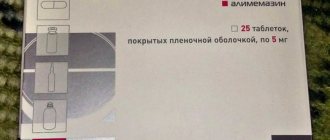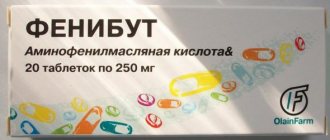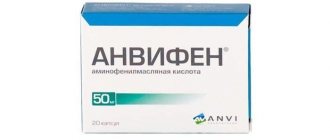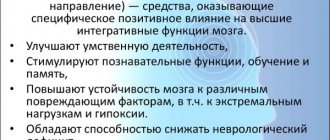Cavinton Cinnarizine Vasobral Mexidol - which is better
Update date: 09/07/2019
Impaired blood circulation in the brain is a fairly common problem among modern people. This pathology can provoke discomfort in health, and can cause a stroke.
Pharmacy shelves are full of a variety of drugs that help in the fight against this disease.
Each of them has unique effects on the body and differences in composition. You need to know what the differences and similarities are between different medications. This is important in order to choose the most suitable and effective drug.
Letters from our readers
Cavinton
The basis of the composition of the drug is vinpocetine, it serves as the main active ingredient. Indications for use of this drug:
- insufficient blood supply to the auditory and visual organs;
- neurological diseases;
- mental personality disorders.
There are 2 types of medicine that differ in the dosage of the active substance:
- Cavinton (5 mg);
- Cavinton Forte (10 mg).
This drug is sold in the form of tablets in cardboard packages. The use of Cavinton may be accompanied by side effects from the circulatory system, as well as the nervous and digestive systems of the body.
This drug is strictly prohibited for use when:
- pregnancy and lactation;
- under age;
- in case of individual allergic reactions to the components included in the drug.
Thanks to its active component, the drug normalizes blood composition.
Cinnarizine
A drug called “Cinnarizine” is found everywhere in any pharmacy. The name of the active component coincides with the trade name of the medicine.
Indications for use of this product:
- cerebral atherosclerosis;
- recovery period after a stroke;
- recovery from head injuries;
- migraine;
- increased fatigue;
- memory and attention disorders;
- dementia;
- Raynaud's syndrome;
- Buerger's syndrome;
- acrocyanosis;
- trophic ulcers;
- pathologies of the vestibular apparatus.
The medicine Cinnarizine has a fairly small number of contraindications. The absolute ones are:
- breastfeeding period;
- individual allergic reactions.
Relative contraindications:
- pregnancy;
- Parkinson's disease.
Among the side effects it is worth noting the following:
- headache;
- increased fatigue;
- dyspepsia;
- sudden weight gain;
- tremor of the limbs.
Vasobral
Vasobral is another drug in the line that affects cerebral circulation. It contains caffeine and a substance called dihydroergocriptine.
Vasobral is prescribed for the following diseases:
- cerebral atherosclerosis;
- rehabilitation therapy after stroke;
- dysfunction of the vestibular apparatus;
- Meniere's syndrome.
This drug is contraindicated for use if there are defects in the structure of the heart valves.
Side effects:
- nausea;
- headache;
- heart rhythm disturbances;
- allergic rash.
Mexidol
The main substance included in Mexidol has a complex chemical name - ethylmethylhydroxypyridine succinate. Mexidol is prescribed by doctors for the treatment of the following diseases:
- encephalopathy;
- atherosclerosis;
- acute forms of pathologies of blood flow in the brain;
- infectious and inflammatory diseases of the oral cavity;
- vegetative-vascular dystonia.
In pharmacies you can find 2 forms of release of this drug: tablets and injections.
The choice of one or another medication option is made by a physician, depending on the complexity and type of disease. The tablet form is usually prescribed for cases of traumatic brain injury, while other cases require the use of injections.
When using Mexidol, the following adverse reactions may occur:
- dyspepsia;
- allergic rash.
Mexidol is prohibited from being prescribed during the gestational period, during lactation, and also to children.
Contraindications for use are chronic liver and kidney failure.
Similarities of drugs
The main similarity of these medications is that they effectively normalize blood flow in the brain. They fight with a sufficient degree of effectiveness against various manifestations of this pathology.
Each of these drugs comes in tablet form. The list of contraindications also includes similar features. The drugs are prohibited for use in childhood, during lactation and in case of individual intolerance to the active ingredients.
Differences
Despite a sufficient number of similarities, these drugs are still significantly different:
- Cinnarizine, Mexidol, Cavinton and Vasobral affect the body with the help of different active components.
- Mexidol is offered in the form of injections and toothpastes.
- Mexidol and Cinnarizine are used to treat a variety of diseases, since their range of effects on the body is very wide.
- Cinnarizine has the fewest contraindications, and Mexidol has the most.
- Mexidol has the fewest side effects.
Doctors' opinion
Due to the fact that these medicinal products are aimed at treating similar pathological manifestations, the question arises - which medicine to give preference to.
Different active substances of these drugs affect problem areas of the body with different strengths. Therefore, the drug, dosage and duration of the course of treatment are prescribed exclusively by a specialist.
The selection of medications is carried out on the basis of the obtained test results and a comprehensive examination of the patient.
Which is better - Cavinton or Cinnarizine?
The effects of these drugs are very similar to each other. However, the active substances in the composition differ. Cavinton normalizes blood circulation and metabolic processes in the human brain, also improves blood composition and brings indicators back to normal. The action of Cinnarizine is similar to Caviton, but it does not affect the level of blood pressure in the blood vessels.
Kaviton is more often used for mental personality disorders and diseases of a neurological nature.
There is no clear answer to the question of which drug is better. The doctor selects the most appropriate remedy based on the general history and condition of the patient.
Which is better – Cinnarizine or Vasobral?
The main difference in the effect of these medications on the human body is the effect on blood pressure. Vasobral quite effectively lowers blood pressure in the vessels, but Cinnarizine does not affect this indicator.
Therefore, the use of the drug Vasobral is contraindicated for people suffering from hypotension.
This drug is a combination drug and, in addition to its effect on the blood vessels of the brain, it effectively helps with improper functioning of the receptors of the nervous system.
What is better - Mexidol or Cinnarizine?
Mexidol is a drug with a fairly large sphere of influence. Therefore, it is often used for monotherapy. Cinnarizine is usually used in complex treatment together with other medications. Also, another advantage in choosing Mexidol is the almost complete absence of side effects.
It is worth noting that the drug Cinnarizine has the lowest cost; in some situations this can play a leading role when choosing a drug.
The range of medicines for normalizing blood circulation is quite wide. In pharmacies you can find drugs for almost any type of pathology and for any budget. Despite the similarity of effects on the body, differences in the composition of the active components make some drugs more universal in use, while others act most accurately on the disease that has arisen.
Which drug to choose in this or that case should only be answered by the specialist who is monitoring the patient. For the most correct and effective treatment, it is important to undergo the necessary examination and tests. Based on the data obtained, you can get a general picture of the body’s condition and select a medicine.
Why is hypertension not treated in Russia?
Hypertension, unfortunately, always leads to heart attack or stroke and death. Only constant use of antihypertensive drugs could allow a person to live.
Now there is a chance to restore blood vessels...
Read more Was this article helpful?
Rate the material on a five-point scale!
( 2 3.00
Source: https://otgipertonii.ru/preparaty/kavinton-cinnarizin-vazobral-meksidol-chto-effektivnee/
Indications for use of Omaron
Indications for the use of Omaron are diseases of the central nervous system, which are accompanied by intellectual and mental disorders:
- treatment of post-traumatic or post-intoxication encephalopathy;
- therapy for cerebral circulatory failure (including atherosclerosis of its vessels, as well as during the recovery period after hemorrhagic and ischemic stroke);
- depression;
- mental retardation in childhood;
- disorders of the vestibular apparatus;
- psychoorganic syndrome, mainly with signs of adynamia and asthenia;
- Meniere's syndrome;
- for the purpose of preventing migraine attacks, as well as kinetosis, in adult and pediatric patients.
- Individual hypersensitivity to piracetam, cinnarizine or other ingredients of the drug Omaron;
- lactase deficiency, lactose intolerance, glucose-galactose malabsorption syndrome (due to the lactose content of the drug);
- severe pathologies of the liver and kidneys (with creatinine clearance (CC) less than 20 ml/min);
- parkinsonism;
- hemorrhagic stroke;
- Huntington's syndrome;
- psychomotor agitation;
- lactation period and pregnancy period;
- age up to 5 years.
Carefully:
- CRF (creatinine clearance - 20-80 ml/min);
- liver and/or kidney pathologies (moderate and mild);
- porphyria;
- increased intraocular pressure;
- violation of hemostasis;
- heavy bleeding;
- surgical interventions on large areas of the body;
- epilepsy;
- hyperthyroidism;
- predisposition to reactions of a neurotic nature;
- cerebral atherosclerosis.
Based on the instructions. The number of contraindications for Fezam is quite similar to Omaron and is small. This is a list of symptoms with syndromes, diseases, various external and internal conditions under which the use of Phezam and Omaron may be undesirable or unacceptable.
Before using the medicine Phezam, the indications for use should be taken into account. The drug is prescribed in the following cases:
- with insufficiency of blood flow in the brain (in the case of vascular atherosclerosis, during the recovery period after an ischemic or hemorrhagic stroke, with encephalopathy of various origins, after a TBI);
- in case of intoxication;
- in diseases of the central nervous system, in which there is a decrease in intellectual-mnestic functions, that is, deterioration of attention, memory, mood;
- with psychoorganic syndrome, in which signs of asthenia and adynamia predominate;
- consequences of traumatic brain injury;
- labyrinthopathy (tinnitus, dizziness, nausea and vomiting);
- asthenic syndrome associated with psychogenic origin;
- Meniere's syndrome;
- for the purpose of preventing migraine, kinetosis;
- in the complex therapy of children who have a psychoorganic syndrome, which has led to low learning ability.
Phezam should not be taken in the following cases:
- in severe forms of renal and liver failure;
- during periods of increased psychomotor agitation;
- with Huntington's chorea;
- during pregnancy and breastfeeding;
- when the patient is under 5 years of age;
- with high sensitivity to the components of the product.
The medicine is prescribed with caution to those patients diagnosed with Parkinson's disease, hemostasis disorders, liver or kidney dysfunction, and severe bleeding.
Cavinton Cinnarizine Vasobral Mexidol - which is more effective. Vasobral at low blood pressure
The basis of the composition of the drug is vinpocetine, it serves as the main active ingredient. Indications for use of this drug:
- insufficient blood supply to the auditory and visual organs;
- neurological diseases;
- mental personality disorders.
There are 2 types of medicine that differ in the dosage of the active substance:
- Cavinton (5 mg);
- Cavinton Forte (10 mg).
This drug is sold in the form of tablets in cardboard packages. The use of Cavinton may be accompanied by side effects from the circulatory system, as well as the nervous and digestive systems of the body.
This drug is strictly prohibited for use when:
- pregnancy and lactation;
- under age;
- in case of individual allergic reactions to the components included in the drug.
Thanks to its active component, the drug normalizes blood composition.
Cinnarizine and Mexidol: which is better, can it be taken at the same time and compatibility
Today, overwork occurs in almost every person. As a result, irritability, absent-mindedness, and tinnitus may occur. It is important to know that these symptoms are associated with impaired blood circulation in the brain tissue, and such a patient needs medical advice.
Ignoring these symptoms for a long time can lead to serious complications. Cinnarizine or Mexidol are prescribed by doctors for hypoxic conditions, depending on the symptoms and diagnosis. Later in the article we will look at the two drugs in detail and figure out which is better.
General information about Cinnarizine and Mexidol
Cinnarizine is a medicine produced by a Bulgarian pharmaceutical plant. The medication consists of a synthetic vasodilator - cinnarizine, a derivative of diphenylpiperazine.
This remedy is most often used for vascular disorders of a spasmodic nature. It also has a number of analogues in the form of Stugeron, Vertizin, Tsinedil. The product is available in the form of tablets for oral administration. And it is taken only as prescribed by a doctor.
Effects of BCC on the body
Mexidol is a free radical inhibitor. The medicine is produced at a pharmaceutical plant in the Russian Federation. The medicine has antihypoxic, stress-protective, nootropic, antiepileptic and anxiolytic effects. The medicine helps improve metabolism and blood circulation.
Available in dosage forms such as tablets and solution for intramuscular and intravenous administration. Most often, patients with severe disease are prescribed injections at the beginning of therapy, and from the second or third week, treatment with tablets. For mild to moderate disease, tablets are prescribed.
Impact principle
The therapeutic pharmacological effect is due to the fact that Cinnarizine belongs to the group of calcium antagonists. Cinnarizine normalizes cerebral, peripheral and coronary circulation.
The product also helps normalize microcirculation. The medicine reduces blood viscosity and thereby protects the blood vessels of the brain from thrombus formation.
It also increases tolerance to oxygen deficiency and thereby has an antihypoxic effect.
The drug does not have a significant effect on blood pressure and heart rate, so any undesirable effect rarely occurs when taking the medication.
Mexidol slows down the oxidative degradation of lipids, which occurs under the influence of free radicals. It also increases the enzymatic activity of the antioxidant metalloenzyme, superoxide dismutase. This ensures the maintenance of optimal levels of superoxide radicals in tissues and also protects the heart during ischemic attacks.
Indications and restrictions
Cinnarizine is taken as a cerebrovascular agent for cerebral circulatory disorders that arise as a result of vasospasm, atherosclerosis, traumatic brain injury, or stroke. The medication helps reduce cerebroasthenic phenomena, headaches, and tinnitus.
Cinnarizine is recommended for migraine pain and Meniere's disease. The medication is also used to reduce the severity of symptoms of obliterating endotheritis, thromboangiitis, Raynaud's disease, and acrocyanosis.
Application of Cinnarizine
Do not take the drug in the following cases:
- in the acute phase of a stroke of hemorrhagic, cerebrovascular type;
- with severe ischemic heart disease;
- for arrhythmia.
Mexidol is used to treat diseases such as transient ischemic attack, mild traumatic brain injury, encephalopathy, vegetative-vascular dystonia, atherosclerosis, coronary heart disease, alcohol withdrawal syndrome, and intoxication with antipsychotic medications.
Mexidol is not used in case of an allergic reaction to the components of the medication, kidney or liver failure. It is also not recommended to drink it during pregnancy and breastfeeding.
Instructions for therapy and compatibility of products
The dosage of Cinnarizine is calculated as follows:
- For blood flow disorders, adults and adolescents are recommended to take 25 mg of the drug three times a day.
- For peripheral circulatory disorders, adults and children who have reached the age of twelve take 50 mg three times a day.
You should not take more than 9 tablets per day, as this will lead to an overdose and a high risk of side effects. You need to increase the dose smoothly and gradually, since sudden changes in dosage have a bad effect on health.
- For imbalances, 25 mg should be used three times a day.
- For motion sickness, take one tablet thirty minutes before the start of the trip. For long trips, take the next tablet after six hours. You should take the medicine only after eating.
As for Mexidol, it is taken one or two tablets three times a day. You should not take more than six tablets per day. The duration of therapy depends on the stage of the disease.
Most often, therapy lasts from two to six weeks of continuous use. In the case of treatment of coronary heart disease, therapy lasts one and a half to two months.
The dose of Mexidol should be increased gradually, the initial dose is one tablet (25 mg) three times a day.
Both drugs are prohibited from being divided, crushed, or chewed. Also, the medicine must be taken with still water at room temperature.
In elderly patients, coordination may be impaired during treatment, so for them the dose must be selected very carefully and adjusted during therapy.
For the drugs Mexidol and Cinnarizine, it is possible to take them together; the course of treatment and dosage in this situation is determined by the doctor. Due to the fact that the drugs act on different parts of the pathogenesis of neurological disorders, Mexidol and Cinnarizine can be taken together. With this combined treatment, the therapeutic effect occurs much faster and the therapeutic effect is much stronger.
Key differences and effectiveness
The medications are very similar in their indications, and at the same time they have different properties. Features of Mexidol are:
- reduction of oxygen deficiency in the brain;
- prevention of convulsive syndrome;
- increased tolerance to irritants and stress;
- normalization of blood flow in vessels;
- nootropic and antioxidant effects.
The active substance is usually classified as a new generation of medicines, and is often used in complex therapy. And Cinnarizine is more often used only as a vasodilator and has a narrower range of indications.
Results of using Mexidol
Therefore, these two medications are often prescribed simultaneously to achieve the desired therapeutic effect. However, any drug combinations must be agreed with the attending physician, since independent treatment can cause harm to health.
The effectiveness of a medication can only be judged based on the indications and individual sensitivity of the patient’s body. For diseases associated with vascular spasm, Cinnarizine is best suited, but for hypoxic conditions Mexidol is more often used. The choice of medicine should be made only by a specialist.
You cannot decide on your own which remedy is more suitable. Also, sometimes the doctor can replace one medication with another if an allergic reaction develops.
Side effects
Sometimes when taking Cinnarizine, the patient may notice drowsiness even during the daytime. Drowsiness is pronounced precisely at the beginning of the course, so for the first days it is better to refrain from driving a car.
Also, sometimes the patient may experience dryness in the mouth. Allergic reactions to both medications may include the development of itching, swelling, redness and swelling of the skin.
Sometimes, to eliminate side effects, it is enough to simply reduce the dose of the drug.
Interaction with other tools
Mexidol is combined with almost any drug that can also be used in the treatment of somatic diseases. As for benzodiazepines, their effects may be enhanced when taken together.
The drug has a similar effect when taken simultaneously with antidepressants, anxiolytics, anticonvulsants, and antiparkinsonian drugs.
The product also helps reduce the toxic effect of ethyl.
When taking Cinnarizine and ethyl alcohol or drugs containing alcohol simultaneously, depression of the central nervous system may occur.
A similar effect occurs when used simultaneously with antihypertensive, nootropic, and vasodilator medications. Also, you should not combine the medicine with tricyclic antidepressants, sleeping pills, and sedatives.
Reviews from doctors and patients
Among patients who took medications, reviews are mostly positive:
Tatyana Petrovna, 65 years old: “For dizziness, the doctor prescribed Cinnarizine to me. I took it for a long time, but did not notice any significant improvement in my condition. Then the doctor recommended that I take it in combination with Mexidol. Already from the second week I noticed improvements.
I’ve been taking it for one month now and I can note that headaches and dizziness are occurring less and less often. But for a therapeutic effect, the doctor said that you need to take them for a couple more months.” Pyotr Vasilyevich, 44 years old: “I have been taking Cinnarizine for several years for tinnitus.
The medication helps me very well with constant long-term use, so you shouldn’t expect improvement immediately after starting treatment. Since I started taking it, I have noticed that my headaches don't hurt as often and the ringing in my ears is getting less frequent.
The medication has never caused me any allergies or side effects. Also, this product is inexpensive, and I can purchase it monthly.”
Anna Viktorovna, 48 years old: “I started taking Mexidol in combination with Cinnarizine after a traumatic brain injury that occurred as a result of an accident.
After the incident, constant headaches began and tinnitus appeared. It was for these symptoms that the doctor recommended complex treatment to me.
Indeed, as soon as I started taking medications, my condition improved noticeably, but there is still a long way to go until complete recovery. It’s important to know that you can’t take these medications without a doctor’s recommendation, so I don’t recommend that anyone take them on their own for headaches.”
Tatyana Anatolyevna, 63 years old: “I take Cinnarizine and Mexidol in courses in the spring and autumn, since it is during this period that I experience exacerbations of coronary heart disease. With timely treatment, I manage to avoid exacerbation of the disease.
The doctor also explained to me that these medications should be taken over a long course, and not as continuous therapy.” Combination treatment always has a stronger effect than monotherapy. Mexidol and Cinnarizine act on different parts of the pathogenesis of the same disease, and therefore they are often prescribed in combination for the treatment of vascular diseases.
Mexidol relieves hypoxia, and Cinnarizine eliminates spasm. Only a specialist can prescribe these medications.
When taken together, the doctor must adjust the dosage, and treatment should begin with the minimum dose.
Also, medications are combined if one drug does not give a positive therapeutic result or has low effectiveness.
And if you have any allergic reaction or unpleasant symptom, you must contact your doctor so that he can suggest the most suitable analogue.
Source: https://Pilyule.com/sravnenie/cinnarizin-i-meksidol/
Overdose
Instructions for use of Omaron recommend taking the tablets orally (orally) while taking food or immediately after meals.
Adult patients are usually prescribed 1-2 tablets of Omaron three times a day, for 30-90 days, depending on the pathology and its severity. Courses of therapy can be carried out 2-3 times a year.
Children after reaching 5 years of age are recommended to take 1 or 2 doses per day, 1-2 tablets. The maximum allowable time for therapy is 3 months.
To prevent kinetosis, adult patients take 1 tablet, children over 5 years old take half a tablet. Omaron is taken 30 minutes before the intended trip and can be repeated after 6-8 hours.
For chronic renal failure (creatinine clearance - 20-80 ml/min), it is possible to use one tablet 2 times a day.
In case of an overdose of Omaron, vomiting, disturbances of consciousness, decreased blood pressure, and extrapyramidal symptoms are possible. When taking a dose of Piracetam of 75 g or more, abdominal pain and bloody diarrhea were observed.
Since there is no specific antidote, gastric lavage is performed and enterosorbents are prescribed. In the future, if necessary, supportive and symptomatic therapy is recommended.
The effectiveness of hemodialysis is 50-60% (relative to piracetam).
The instructions for using Phezam, which are provided in the annotation for the drug, indicate that the medicine should be taken 1-2 capsules three times a day for one to three months. The duration of treatment depends on the severity of the disease. The drug is usually taken in courses - 2-3 courses annually.
Children over 5 years old are advised to take 1-2 capsules 1-2 times a day. Capsules are used for one and a half to three months. Capsules should be taken by swallowing them whole, without violating the integrity of the capsule. You should take the tablet with half a glass of water, and it should not be hot.
Many users ask about capsules, how to take them - before or after meals. The instructions say that there is no particular difference in whether to take the product before or after meals. But it is optimal to drink capsules 20-30 minutes after eating. It is advisable to take the medicine at the same time every day.
Doctors warn that you cannot take the medicine for longer than 3 months - a break is necessary between courses.
As a rule, Phezam is well tolerated by patients and when taking large doses of the drug, no significant side effects are observed, which requires discontinuation of treatment. In case of overdose, patients may experience abdominal pain. If you take too large doses of the medicine, you need to rinse your stomach and induce vomiting. If there is such a need, perform hemodialysis and symptomatic treatment. There is no specific antidote.
Cavinton Cinnarizine Vasobral Mexidol - which is more effective
The basis of the composition of the drug is vinpocetine, it serves as the main active ingredient. Indications for use of this drug:
- insufficient blood supply to the auditory and visual organs;
- neurological diseases;
- mental personality disorders.
There are 2 types of medicine that differ in the dosage of the active substance:
- Cavinton (5 mg);
- Cavinton Forte (10 mg).
This drug is sold in the form of tablets in cardboard packages. The use of Cavinton may be accompanied by side effects from the circulatory system, as well as the nervous and digestive systems of the body.
This drug is strictly prohibited for use when:
- pregnancy and lactation;
- under age;
- in case of individual allergic reactions to the components included in the drug.
Thanks to its active component, the drug normalizes blood composition.
Clinical and pharmacological group
A drug that improves cerebral and peripheral blood circulation. Vasodilating agent.
Conditions for dispensing from pharmacies
Dispensed with a doctor's prescription.
Prices
How much does Vasobral cost? The average price in pharmacies is 1,200 rubles.
Release form and composition
The active substances of Vasobral are:
- Caffeine (40 mg in 1 tablet, 10 mg in 1 ml of solution);
- Alpha-dihydroergocriptine mesylate (4 mg in 1 tablet, 1 mg in 1 ml of solution).
Pharmacological effect
Thanks to its composition, Vasobral acts on the receptors of the nervous system. During the course of treatment with the drug, platelet aggregation in the patient’s blood decreases. The permeability in the walls of blood vessels also decreases significantly. The patient experiences improvements in blood circulation and restoration of metabolic processes in the brain. Vasobral strengthens brain tissue and provides immunity to hypoxia.
Caffeine, which is part of the drug, stimulates the nervous system and affects the blood vessels and respiratory tract. This substance improves mental activity and increases human performance. At the same time, the feeling of fatigue quickly passes even with strong brain function.
The time it takes to remove the drug from the body is about 2 hours. The maximum concentration of the drug in the blood is 8 mg. The time to achieve this concentration is half an hour.
Indications for use
What does it help with? Experts recommend the peripheral and central vasodilator “Vazobral” as an effective remedy for the following pathological conditions:
- negative symptoms – persistent dizziness, tinnitus.
- persistent memory loss;
- chronic course of venous insufficiency;
- Raynaud's disease;
- Meniere's disease;
- ischemic disorders of various localizations;
- significant deterioration in concentration;
- severe cerebrovascular insufficiency;
- distress due to meteosensitivity;
- intellectual disability – excessive forgetfulness, inability to concentrate;
- residual manifestations of previous cerebrovascular accidents;
- retinopathy.
Source: https://zdorovo.live/nevralgiya/kavinton-tsinnarizin-vazobral-meksidol-chto-effektivnee-3.html











